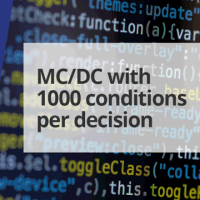Testing has to satisfy two objectives: it has to be effective, and it has to be cost-effective. Testing is effective if it can distinguish a correct product from one that is incorrect. Testing is cost-effective if it can achieve all it needs to do at the lowest cost (which usually means the fewest tests, least amount of effort and shortest amount of time).
Measuring code coverage during testing can help to meet these two objectives by:
- Assessing effectiveness by demonstrating that the tests exercise all relevant features of the code during testing. Example features are branches, statements, function calls or decisions.
- Improving cost-effectiveness by allowing the developers of tests to determine whether any tests are redundant, in other words where multiple tests exercise the same features without demonstrating anything new.
Clearly there is a balance between cost-effectiveness and effectiveness of testing. Both can be improved to a certain point, after which there is a trade-off. Different coverage criteria allow this balance to deliver a level of rigor in the testing that is appropriate for the level of reliability, or the software integrity level (SIL) of the system.

 Hybrid electric pioneers, Ascendance, join Rapita Systems Trailblazer Partnership Program
Hybrid electric pioneers, Ascendance, join Rapita Systems Trailblazer Partnership Program
 Magline joins Rapita Trailblazer Partnership Program to support DO-178 Certification
Magline joins Rapita Trailblazer Partnership Program to support DO-178 Certification
 Eve Air Mobility joins Rapita Systems Trailblazer Partnership Program for eVTOL projects
Eve Air Mobility joins Rapita Systems Trailblazer Partnership Program for eVTOL projects
 How to certify multicore processors - what is everyone asking?
How to certify multicore processors - what is everyone asking?
 Data Coupling Basics in DO-178C
Data Coupling Basics in DO-178C
 Control Coupling Basics in DO-178C
Control Coupling Basics in DO-178C
 Components in Data Coupling and Control Coupling
Components in Data Coupling and Control Coupling
 DO-278A Guidance: Introduction to RTCA DO-278 approval
DO-278A Guidance: Introduction to RTCA DO-278 approval
 ISO 26262
ISO 26262
 Data Coupling & Control Coupling
Data Coupling & Control Coupling
 Verifying additional code for DO-178C
Verifying additional code for DO-178C
 DO-178C Multicore In-person Training (Bristol)
DO-178C Multicore In-person Training (Bristol)
 DO-178C Multicore In-person Training (Fort Worth, TX)
DO-178C Multicore In-person Training (Fort Worth, TX)
 DO-178C Multicore In-person Training (Toulouse)
DO-178C Multicore In-person Training (Toulouse)





















